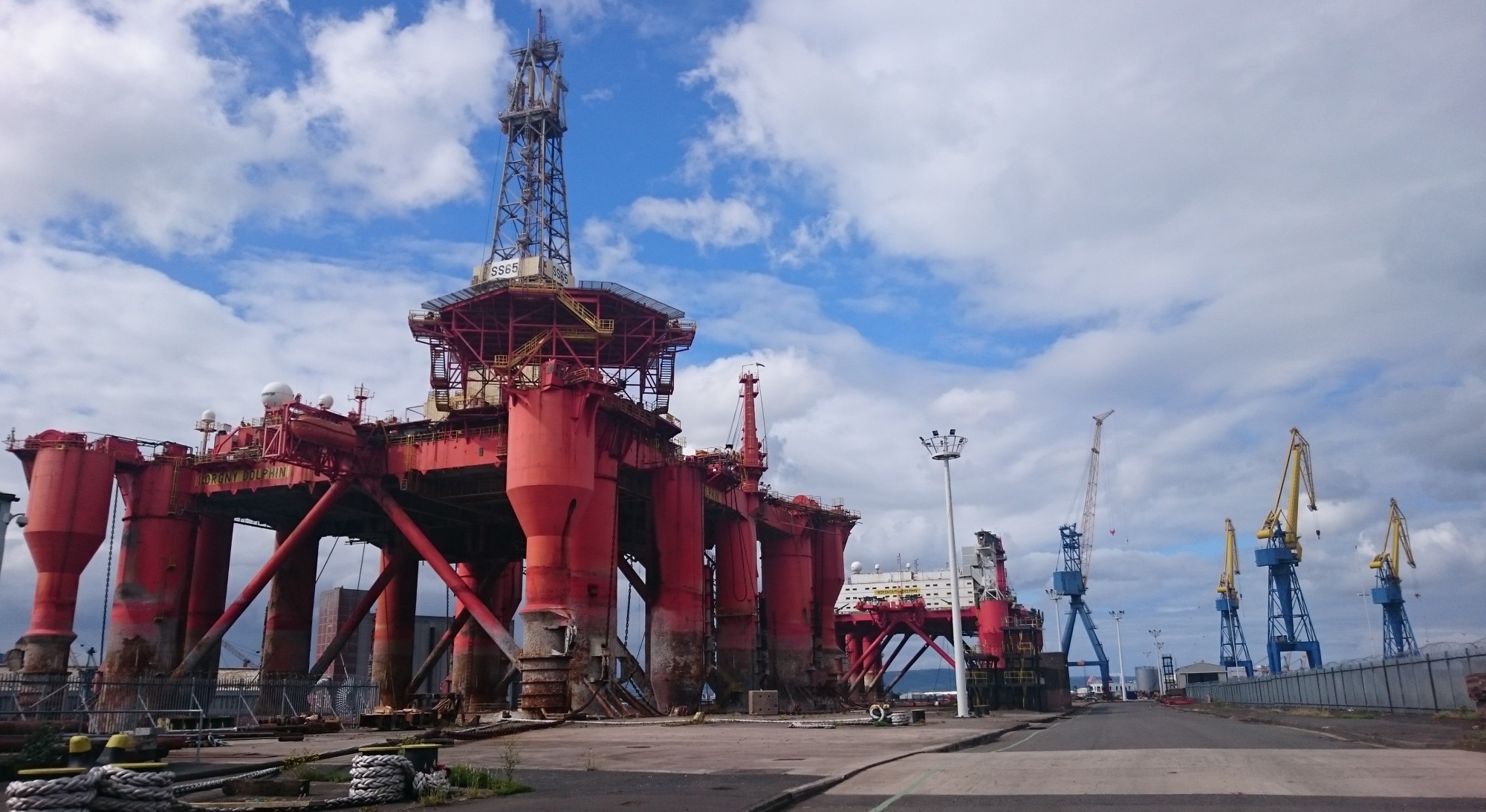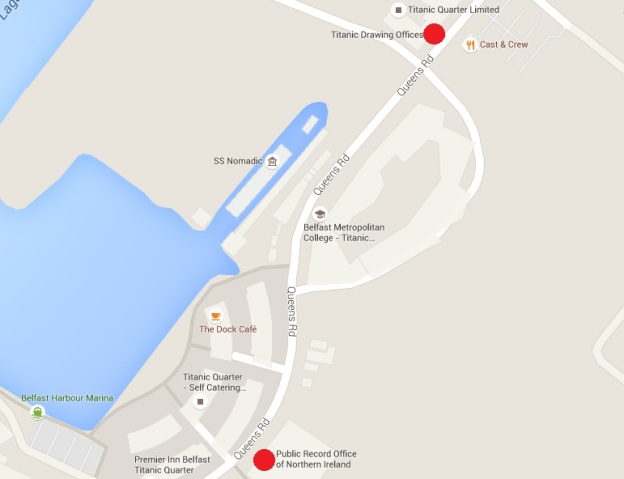- Public Records Office
- ‘Ulster Names’ by John Hewitt
- ‘Heritage’ by Felicity Straker Graham
- Porcelain!
- ‘Bonnet’ by Rita Duffy
- ‘Hand of Ulster’ by RIta Duffy
- ‘Winged Boots’ by RIta Duffy. According to its plaque, this piece “symbolises the generations of designers and workers, who, whilst rooted and grounded in Belfast’s industrial heartland, contributed to the history of flight”.
- Quick tea break in the PRONI cafe
- H&W Drawing Offices
- Draughtsmen in the Drawing Offices
- Historical layers
In a previous post Clare wrote about our trip to the Titanic Dock and Pump House as part of the European Heritage Open Day (“EHOD”) in Northern Ireland. This post though focuses on our next EHOD outing to the Public Record Office of Northern Ireland (“PRONI”) and the Harland & Wolff Drawing Offices. To PRONI first. As the name suggests, PRONI houses public records, but it also has a large collection of private documents. According to an exhibition at the centre, PRONI began collecting private records to fill the archival gap left after the Public Record Office in Dublin was destroyed in 1922, taking with it most of its records. The exhibition goes on to note that these private collections “add colour and texture to the official records, creating a wide-ranging and varied archive”. Types of records included in the archive are government and court papers and documents deposited by individuals and businesses.
The first thing to note about PRONI is that its website is exemplary. An odd thing to highlight you may think, but go check it out here. We had a look at the website before we went on our tour and it literally answered every question we had, from clear opening times and days and how to register as a member, to what to expect on your first visit and information on their archives. The second thing to note is that the centre itself is beautiful. PRONI re-located to Titanic Quarter in 2011, and as soon as you enter the building, you can see that a lot of focus has been placed on making it fresh, modern and relevant. White walls, huge windows and open-plan floors invite you in, while modern art pieces adorn the walls and capture your attention. A particularly striking piece by Felicity Straker Graham, a tribute to those who have contributed to PRONI, is a display of porcelain sheets, finely moulded to form intricately-designed pieces of paper. The photos don’t do it justice, but the sheets of porcelain are so delicate that you can see the light shining through them.
On to the actual tour itself, our group got a fascinating behind-the-scenes look at the research areas, labs and archives. We were given tips on how to search for documents in the computer room, and then led to the reading room where you can peruse your chosen document at your leisure. Our guide pointed out that, perhaps unexpectedly, you don’t wear gloves when reading old documents, and that she would tell us why later in the tour. She never told us. We forgot to ask. Cue several months of being sporadically plagued by this question. As you might expect, old documents can suffer major damage. We were told about one particular document that was completely saturated and in the process of being dried out. Fortunately PRONI has a conservation lab to try to restore these documents so readers can enjoy them.
The lab took us right back to third form Chemistry. Suppressing an urge to fire up a bunsen burner, we moved on to a cool reprographics lab where one of their projects is to merge old and new photos to show you what an area looked like then and now. Finally we made our way down to see where all the archived documents are kept. These rooms contain shelves and shelves of hundreds of boxes and the temperature is noticeably lower than in the rest of the building to help preserve the documents. Most of the documents in these rooms are accessible to the public, however there are also a large number that have to remain confidential either indefinitely or for a set amount of time. We left the tour inspired to hunt through old documents, maybe to learn more about our family history, or perhaps to read through some historical documents on the Titanic.
As mentioned in a previous post, I will be writing a post on my Grandas’ careers in the shipyard, and we thought this would be the perfect topic to research in PRONI. Hoping to find some sort of mention of them in relation to the shipyard, we chatted to a member of staff who reckoned our best bet would be the archived Harland & Wolff personnel papers. Alas, these papers aren’t available to the public for confidentiality reasons, and we hit a bit of a brick wall. If you have any suggestions for where else we could look please leave a comment! Not the result we were hoping for, but we’ll definitely find another project so we have an excuse to go back. Plus, it’s free to become a member and look at the documents, and your card lasts for ten years. It would be a great place to spend a grey, rainy day, engrossed in old personal diaries of world war veterans or investigating your family tree. The centre isn’t open at weekends, but you can go during the day Monday to Friday, and Thursday evenings from February to November. Make sure to check out the cafe too. It does a pretty decent scone with jam and cream.
After our tour of PRONI and a talk in its lecture theatre on the SS Nomadic during the EHOD weekend (see our next post), we made our way to the Harland & Wolff Drawing Offices. Titanic Foundation’s tourist brochure notes that these offices, built around 1885-1917, are the oldest remaining structures of the shipbuilding industry on Queen’s Island. It was here that great ships such as the Titanic, Olympic and HMS Belfast were designed, perhaps by the draughtsmen you see in the black and white photo above. According to Titanic Foundation, the building “is the most critical and authentic physical and emotional link which connects the Titanic and Olympic Slipways, SS Nomadic, HMS Caroline and the Thompson Dock into a sustainable world class heritage destination”.
It was, therefore, with particular sadness that I learned that the Drawing Offices are to be converted into a boutique hotel. True, the offices have been vacant for quite some time, and the funding will not only help restore the building, but also create jobs and help attract more tourism to the area. However, as I stood in the high-ceilinged shell of a room, surveying the layers of colourful peeling paint, a hint to the building’s long-standing history in the area, and following the streams of light directed through the multitude of windows onto the long drawing tables, helpfully laid out as a visual aid, I could almost see the rows of draughtsmen hunched over their desks with rulers and sharpened pencils, meticulously mapping out every rivet and stairway of one of the many innovative ships proudly conceived in the Belfast shipyard. I generally support and see the value in restoring and re-purposing buildings. But I can’t help but feel that this experience, this unique opportunity to stand between the crumbling walls and wooden desks and reflect on our city’s maritime heritage, would be somewhat out of our grasp with the presence of a hotel lobby and brightly coloured suitcases.
That being said, the hotel will reportedly have “heritage at its core”, and I still hope to be pleasantly surprised by (perhaps even enthusiastic about!) the restoration work. It’s true, after all, that just because it will be a different experience doesn’t necessarily mean it will be a worse experience. Please do let us know your thoughts on the re-purposing of the Drawing Offices and other historical buildings. By the time we learned that the Drawing Offices would close to the public in their current state for good, we almost missed out on accessing them. Thankfully, in a last-minute miracle, we discovered that they would open once again during EHOD 2015. Access was limited, however, so we only got to see a small part of the Drawing Offices. Helpfully, though, many of the documents from the offices are available to view in PRONI, so we, and future generations, will still have extensive access to the building’s history and legacy.
We are incredibly lucky to have, in this small area, access to not only educational talks and discussions, through which we can explore Belfast’s shipbuilding past in its economic, social or political context, but also to authentic documents, artefacts and actual historical buildings. To re-purpose the PRONI quote in the first paragraph, these facets combine to add colour and texture to the black and white photos we so often see of the docks and their workers.
-Rachel



























































